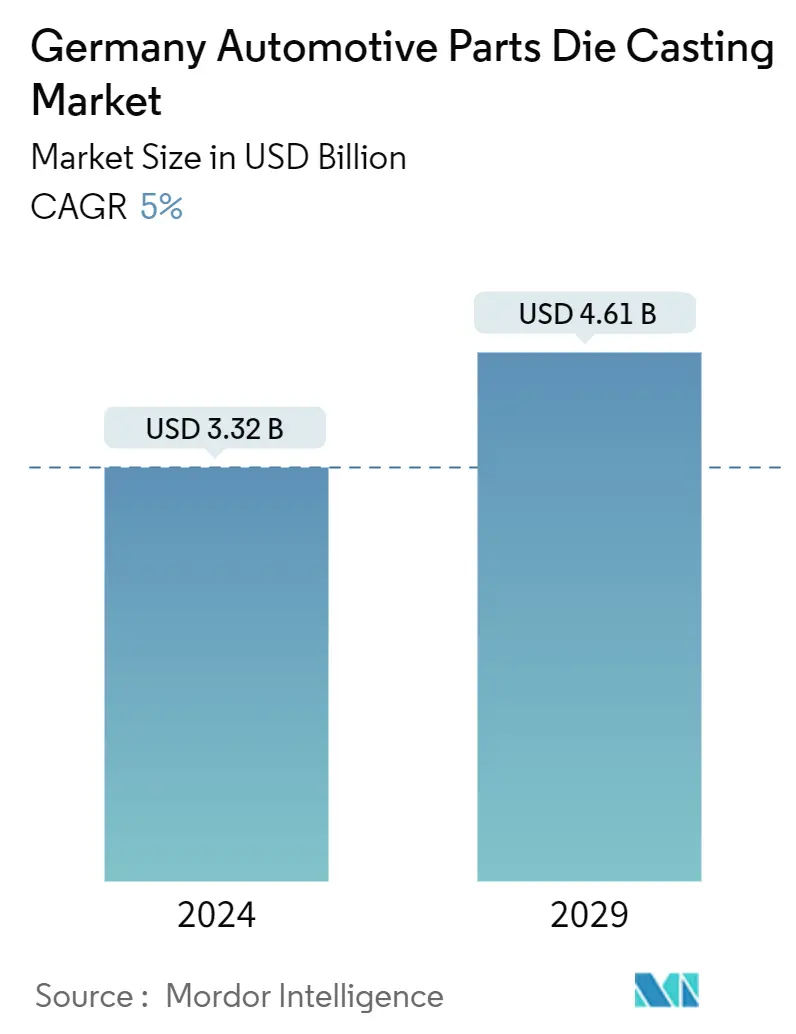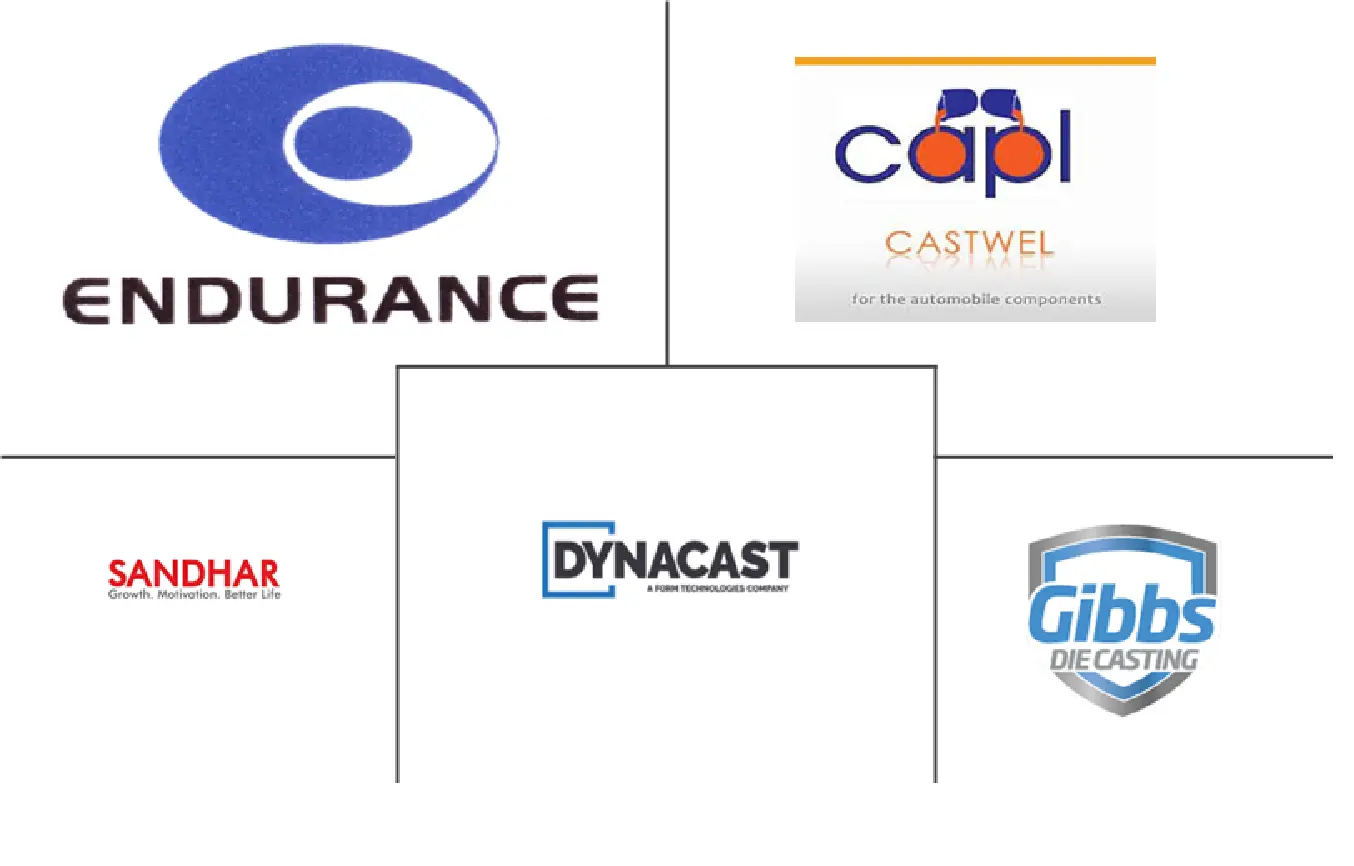Market Size of Germany Automotive Parts Die Casting Industry

| Study Period | 2019 - 2029 |
| Base Year For Estimation | 2023 |
| Market Size (2024) | USD 3.32 Billion |
| Market Size (2029) | USD 4.61 Billion |
| CAGR (2024 - 2029) | 5.00 % |
| Market Concentration | Low |
Major Players
*Disclaimer: Major Players sorted in no particular order |
Germany Automotive Parts Die Casting Market Analysis
The Germany Automotive Parts Die Casting Market size is estimated at USD 3.32 billion in 2024, and is expected to reach USD 4.61 billion by 2029, growing at a CAGR of 5% during the forecast period (2024-2029).
- The COVID-19 pandemic had a negative impact on the die-casting industry. The supply chain was disrupted as several major economies across the world went into lockdown. During this time, all manufacturing units and original equipment manufacturers (OEM) factories were obliged to suspend production and activities. After the economic recovery, demand returned to the market, with considerable demand for die-cast parts in the automobile industry as customer preferences shifted to lighter cars. The current trend is projected to continue, driving the market growth.
- Over the long term, the major presence of automotive component manufacturers across the country is likely to witness major growth in the market. The country is one of the world's leading car producers and is well-known for its excellence in the automotive industry. Several die-casting manufacturers are expanding their manufacturing facilities across the country, which in turn is likely to propel the growth during the forecast period.
- In June 2022, Handtmann, the renowned German solution provider specializing in light metal components, made a significant investment in the Bühlermega casting equipment plant located in Germany. This strategic move allowed Handtmann to further strengthen its position in the market and expand its production capacity for structural parts and body-in-white components throughout the country. The investment was a crucial step in the company's growth and commitment to delivering high-quality solutions to its customers.
- Machinery exports to the European markets showed a slight increase in growth; German machinery exports to the Euro-partner countries rose by 6.3%, while those to the EU-28 increased by 6.6%. Major overseas exports expanded even faster. Exports to China rose by 9.6%, and exports to the United States by 7.1%. However, during the COVID-19 pandemic, the production of raw aluminum dropped by 14% during the first half of 2020, and the processing and production of finished products were reduced by more than 5%.
- Above mentioned trends are likely to continue to grow, owing to the improving country's economic growth, which is further driving the die casting machinery companies to invest in upgrading the advanced CNC die casting machinery, as well as export them to neighboring and international countries. Further, Georg Fischer, Wolf Group, VOIT Automotive GmbH, Rheinmetall AG, and OrtalDie casting are some of the leading players in the country. Rheinmetall AG offers its products to both regional and international manufacturers.
Germany Automotive Parts Die Casting Industry Segmentation
To create pieces from molten metal, automotive die casting employs a metal molding technique (die). They then cool the metal and solidify it into machined items such as engine blocks or gearboxes. This approach eliminates waste while saving manufacturers and customers time and money.
The Germany automotive parts die casting market is segmented by the production process (pressure die casting, vacuum die casting, squeeze die casting, and semi-solid die casting), application type (engine parts, transmission components, body parts, and other applications), and by material type (aluminum, zinc, and magnesium).
The report offers the market size in value (USD) and forecasts for all the above segments.
| Production Process Type | |
| Pressure Die Casting | |
| Vacuum Die Casting | |
| Squeeze Die Casting | |
| Semi-Solid Die Casting |
| Raw Material | |
| Aluminum | |
| Zinc | |
| Magnesium |
| Application Type | |
| Engine Parts | |
| Transmission Components | |
| Body Parts | |
| Other Applications |
Germany Automotive Parts Die Casting Market Size Summary
The Germany Automotive Parts Die Casting Market is poised for significant growth over the forecast period, driven by the country's robust automotive industry and the increasing demand for lightweight vehicle components. The market is experiencing a resurgence following the disruptions caused by the COVID-19 pandemic, with a notable shift towards the use of aluminum in die-casting processes. This shift is largely due to the automotive sector's focus on producing lighter and more fuel-efficient vehicles, particularly with the rising adoption of electric vehicles. The presence of major automotive manufacturers and component suppliers in Germany further bolsters the market, as these companies invest in advanced die-casting technologies to enhance their product offerings.
Key players in the market, such as Rheinmetall AG, GF Automotive, and DGS Druckguss Systeme, are expanding their production capabilities and investing in innovative technologies to meet the growing demand for die-cast parts. Strategic investments, like Handtmann's expansion of its casting facilities, highlight the industry's commitment to maintaining high-quality production standards. The market's growth is also supported by favorable economic conditions and increasing exports of machinery and die-casting equipment to European and international markets. As the automotive industry continues to evolve towards electric and hybrid vehicles, the demand for high-pressure die-casting components is expected to rise, further driving the market's expansion in the coming years.
Germany Automotive Parts Die Casting Market Size - Table of Contents
-
1. MARKET DYNAMICS
-
1.1 Market Drivers
-
1.1.1 Increasing Aluminium Use in Die Casting Equipment is Likely to Drive Demand for the Die-Casting Market
-
-
1.2 Market Restraints
-
1.2.1 High Raw Material Prices May One of The Factors That Hindering Target Market Growth.
-
-
1.3 Porter's Five Forces Analysis
-
1.3.1 Threat of New Entrants
-
1.3.2 Bargaining Power of Buyers/Consumers
-
1.3.3 Bargaining Power of Suppliers
-
1.3.4 Threat of Substitute Products
-
1.3.5 Intensity of Competitive Rivalry
-
-
-
2. MARKET SEGMENTATION (Market Value in Million/Billion)
-
2.1 Production Process Type
-
2.1.1 Pressure Die Casting
-
2.1.2 Vacuum Die Casting
-
2.1.3 Squeeze Die Casting
-
2.1.4 Semi-Solid Die Casting
-
-
2.2 Raw Material
-
2.2.1 Aluminum
-
2.2.2 Zinc
-
2.2.3 Magnesium
-
-
2.3 Application Type
-
2.3.1 Engine Parts
-
2.3.2 Transmission Components
-
2.3.3 Body Parts
-
2.3.4 Other Applications
-
-
Germany Automotive Parts Die Casting Market Size FAQs
How big is the Germany Automotive Parts Die Casting Market?
The Germany Automotive Parts Die Casting Market size is expected to reach USD 3.32 billion in 2024 and grow at a CAGR of 5% to reach USD 4.61 billion by 2029.
What is the current Germany Automotive Parts Die Casting Market size?
In 2024, the Germany Automotive Parts Die Casting Market size is expected to reach USD 3.32 billion.

